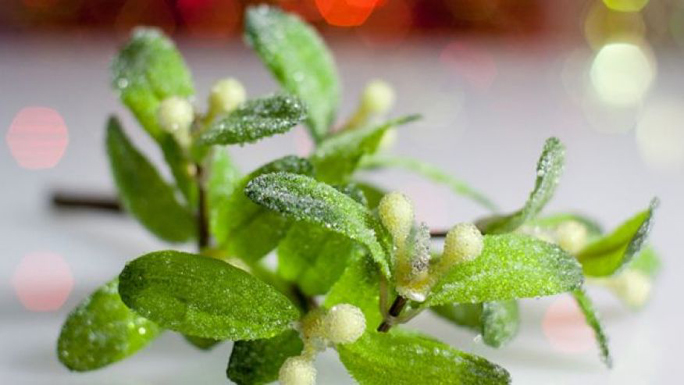
Mistletoe
At holiday time, mistletoe emerges as a plant strategically placed so that those who walk under it must pause to kiss. European, African, Australian, Asian and North American in origin -- and healing in nature -- mistletoe offers both tradition and mystery.
A parasitic plant, mistletoe attaches to limbs or branches of trees, and sets up shop. Through a parasitic fungus connected to its tip, the mistletoe attaches to the host plant, and derives both moisture and nutrients required to grow. In time, mistletoe’s fungal tip penetrates the tissue of the host, thereby deriving nutrients directly from that organism. Growing on as many as two hundred different species of trees and bushes, mistletoe is readily spotted, looking much like a squirrel’s nest.
Over nine hundred species of mistletoe are known, and the plant itself is a source of nourishment for a great many species of animals and birds. The fruits of mistletoe are drupes, that is large seeds with a small amount of fruit around them. These are most typically eaten by birds, who disperse mistletoe when those seeds are excreted.
As a traditional medicine, use of mistletoe dates back to the Druids, who were an intellectual class of Celts during the Iron Age. Among other things, the Druids were known for the ritual of oak and mistletoe, which involved cutting an oak tree, harvesting the mistletoe from the tree, and making a potion of the mistletoe purported to possess broad healing and restorative properties.
From the time of the Druids to the present, mistletoe has played a role in traditional medicine as a remedy for headaches and seizures. Today the leaves, shoots and berries of the mistletoe plant are well known sources of various compounds with cancer-fighting activity.
Four categories of compounds are used as cancer therapies, including alkaloids, polysaccharides, lectins and viscotoxins. From these various agents a range of anti-cancer drugs have been developed, including the products Lektinol, Helixor, Iscador and several other registered cancer drugs. These are most widely employed in European countries, where use of mistletoe for the treatment cancer is fairly common.
Various extracts of mistletoe demonstrate cancer-killing activity. The plant appears to work by enhancing activity of the immune system, and by inhibiting angiogenesis, the process by which cancers develop new blood vessels for nourishment. Anti-angiogenesis, the cutting off of this blood supply, is a powerful approach to fighting cancer.
The U.S. National Institutes of Health finds fault with several of the mistletoe studies that have been conducted in Europe, and has published the opinion that these studies are not up to high standards. A number of mistletoe studies focus on its use as an adjuvant therapy, taken in the wake of more aggressive chemotherapy. In these scenarios, mistletoe has helped cancer patients to fare better, with fewer adverse effects than without the mistletoe.
Over fifty clinical trials of mistletoe for cancer treatment have been examined by NIH, and the results are somewhat encouraging. Those who are given mistletoe extracts as part of cancer therapy experience improved quality of life, and reduced fatigue, nausea, vomiting and depression after treatment. Rates of survival appear no different among those who receive mistletoe and those who do not.
The long, slow, painful road to approval or denial of drug status in the U.S. inexorably rolls on for mistletoe. Appearing to be far from a miracle cure, mistletoe may play a useful role in cancer treatment. But as of yet the FDA has not approved mistletoe as a cancer medicine, and you cannot legally obtain mistletoe extracts in the U.S. For now, though kissing under the mistletoe is admissible in most places, you still need to travel to Europe to use this plant for cancer.

